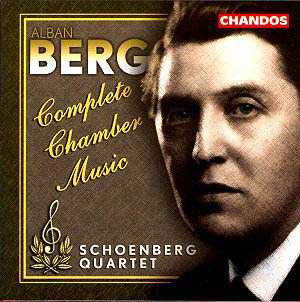This is a most useful collection. The most important items
(and, in fact, the only truly ‘genuine’ chamber works) are the String
Quartet and Lyric Suite. The others are arrangements of more
than passing interest (at least the ones by Berg himself) but it is probably
the two big works that will interest collectors most.
The Schoenberg Quartet’s stiffest competition comes
from the eponymously named Alban Berg Quartet, who have recorded both
pieces twice for EMI. The earlier, 1970s performance is now on a mid-price
disc, generously coupled with quartets by Webern and Urbanner. The later
(and arguably more intense) digital version is the benchmark disc in
these works, but now seems short measure at 47 minutes. There is no
doubting the Berg’s intensity and sheer high-powered virtuosity in these
difficult pieces, and the Schoenbergs are only partially successful
in conveying the overheated emotion that runs throughout many passages.
But they make their own case with playing of particular delicacy and
expressive eloquence. The Op. 3 Quartet is played with a real
feeling for its inherent contrapuntal complexity – this was the last
piece Berg completed under the watchful eye of Schoenberg, whose principle
of ‘developing variation’ Berg was trying to implement. The marvellous
overlapping phrases are elegantly executed (try 1.06 into the first
movement) but the big climaxes (such as 4.58) are a shade under-powered
when compared to the Alban Bergs. The second movement, which has many
traits of the mature Berg to come, is nicely despatched, the ghostly
sul ponticello passages being particularly successful.
The Lyric Suite is an unquestionable masterpiece,
and the performance here has the same strengths and disappointments
as above. The flautando passage at 2.54 into the first movement
is played at a true ppp, but ensemble at 6.03 is slightly scrappy. The
fifth movement really tests sonority and technique, but they play very
atmospherically in the amazingly daring passage at 0.58. The last movement’s
outpouring of love, with its overt Wagner overtones (complete with Tristan
quote at 3.27) is generally successful and enjoyable, and it is really
only the last ounce of excitement and intensity that is missing.
The remainder of the disc is made up of arrangements,
some of which are more interesting than others. There doesn’t seem to
be much point in an instrumental version of Hier ist Friede,
the fifth of the Altenberg Lieder, when the original is so perfect,
especially when heard in its proper sequence. Berg made this arrangement
as a gift for Alma and Anne Mahler, and he obviously thought it could
stand on its own (Chandos even print the text) but it’s no match for
the original. The Four Pieces Op. 5 are, of course, the exquisite
Webernian miniatures for clarinet and piano, here arranged by the Schoenberg’s
viola player, Henk Guittart. This seems slightly bizarre, considering
an excellent clarinet player was on hand for the Chamber Concerto
Adagio, and in any case it is only partially successful in conveying
the mood of the original. I like Berg’s own ingenious arrangement of
the Adagio, where the clarinet alone takes the place of the 13
wind instruments of the original; textures are clear, complicated polyphony
unforced, and generally this beautifully played 13-minute movement is
a gem.
The typically reverberant but spacious recording is
warm and clear, with intimacy not sacrificed. Concise but very helpful
notes are by the leading Berg authority Douglas Jarman. Enthusiasts
will probably already have the main works, but this disc, with its quirky
little fillers, is certainly not without merit.
Tony Haywood


